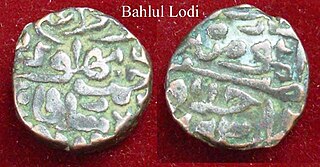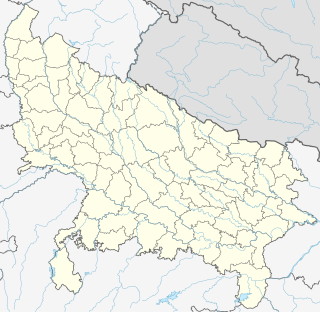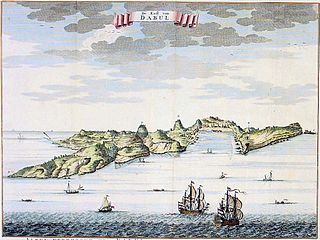
Muhammad Jaunpuri, son of Abdullah titled Syed Khan, was born in Jaunpur, Uttar Pradesh on Monday the 14th Jamadi-ul Awwal 847 Hijri corresponding to 9 September 1443. His grandfather Usman came to India from Samarkand with his family and settled down in Jaunpur on the invitation of the Sharqiya King. Jaunpuri was a descendant of Imam Moosa Al-Kazim. He extensively traveled throughout India, Arabia and Khorasan.

Bahlul Khan Lodi was the chief of the Pashtun Lodi tribe. Founder of the Lodi dynasty from the Delhi Sultanate upon the abdication of the last claimant from the previous Sayyid rule. Bahlul became sultan of the dynasty on 19 April 1451.

Zaidpur is a town and a nagar panchayat in Barabanki district, Uttar Pradesh, India.

Gauḍa was one of the prominent capital cities in the history of the Indian subcontinent. It is located on the border between modern-day India and Bangladesh, with most of its ruins on the Indian side and a few structures on the Bangladeshi side. The course of the Ganges River was located near the city before a change in the course of the river. Gauda rivaled other imperial cities in the Indian subcontinent in terms of wealth and population.

Jaunpur district is a district in the Varanasi Division of the Indian state of Uttar Pradesh. The district headquarters is Jaunpur which is situated on the banks of the Gomti River. It is located 228 km southeast of the state capital Lucknow. The district has two Lok sabha seats and nine Vidhan Sabha seats. According to the 2011 census, Jaunpur has a gender ratio of 1,024 females to 1,000 males, the highest in Uttar Pradesh. The main languages are Hindi, Urdu, Awadhi and Bhojpuri.
All India Shia Personal Law Board (AISPLB) is an organisation formed in January 2005 to represent the rights of Shia in India. It was felt that the current board, the All India Muslim Personal Law Board (AIMPLB) had been neglecting the views of Shia Muslims in India. Maulana Kalbe Sadiq, vice chairman of the Shia board is also senior vice president of All India Muslim Personal Law Board (AIMPLB).

Indo-Islamic architecture is the architecture of the Indian subcontinent produced by and for Islamic patrons and purposes. Despite an initial Arab presence in Sindh, the development of Indo-Islamic architecture began in earnest with the establishment of Delhi as the capital of the Ghurid dynasty in 1193 CE. Succeeding the Ghurids was the Delhi Sultanate, a series of Central Asian dynasties that consolidated much of North India, and later the Mughal Empire by the 15th century CE. Both of these dynasties introduced Persianate, Turkic and Islamicate architecture and art styles from Western Eurasia into the Indian subcontinent.
Nasiruddin Mahmud Shah was a Sultan of Bengal. He was a descendant of Sultan Shamsuddin Ilyas Shah of Bengal. Nasiruddin took the title of Nasiruddin Abul Muzaffar Mahmud Shah when he ascended to power in 1435 AD. It was twenty years since his dynasty lost the power in the first phase.

Taj-ul-Masajid is a mosque situated in Bhopal, India. The name is also spelt as Taj-ul-Masjid. "Masajid" means "mosques" and "Taj-ul-Masajid" literally means "Crown Among Mosques". It is the largest mosque in India and one of the largest mosques in Asia's.
Mosques in Kolkata refers to mosques in the city of Kolkata, in India.

Dabhol, also known as Dabul, is a small seaport town in the Ratnagiri district of Maharashtra in India. It is located on the northern and southern sides of the Vashishthi river that later flows by Chiplun town. The Dabhol LNG power plant that had been set up by Enron is located on the Southern side of Dabhol, between the villages of Veldur and Ranavi.

The Great Mosque of Kufa, or Masjid al-Kūfa, or Masjid al-Mu'azam/al-A'azam located in Kūfa, Iraq, is one of the earliest and holiest surviving mosques in the world. The mosque, built in the 7th century, contains the remains of Muslim ibn ‘Aqīl - first cousin of Imām Husayn ibn ‘Alī, his companion Hānī ibn ‘Urwa, and the revolutionary Mukhtār al-Thaqafī.

Atala Masjid or Atala Mosque is a 14th-century mosque in Jaunpur, Uttar Pradesh, India. It is one of the chief tourist attractions in Jaunpur.

Jama Masjid one of the largest mosque of India or Jama Mosque or Jami Masjid or Badi Masjid is a 15th-century mosque built by Hussain Shah Sharki in Jaunpur, Uttar Pradesh, India. It is one of the chief tourist attractions in Jaunpur. The mosque is 2.2 km north-northeast of Jaunpur, 7.3 km northwest of Zafarābād, 16.8 km north-northeast of Mariāhū, 26.3 km west-northwest of Kirākat.

The Gates of Delhi were city gates in Delhi, India, built under dynastic rulers in the period that could be dated from the 8th century to the 20th century. They are the gates in

Aurangabad furnished a genial soil for the spread of Islam, and was the centre of great missionary movements in the 8th century of the Hijri. The district is home to the earliest of Sufi saints of the Deccan. The town of Khuldabad contains the shrines of the most famous saints of the Dakhan. Initially it was known as Rauza meaning "garden of paradise". It is known as the Valley of Saints, or the Abode of Eternity, because in the 14th century, several Sufi saints chose to reside here. The tomb of the Mughal emperor Aurangzeb and his trusted general Qamar-ud-din Khan, Asaf Jah I first Nizam of Kingdom of Hyderabad are located in this town, so is the tomb of Malik Ambar.

The Jama Masjid commonly known as the Jama Masjid Rahmaniya, the oldest mosque in Rupandehi, Bhairahawa, Nepal. It is the largest and best known mosque in Rupandehi District of Nepal. It was completed in 1950 AD. This is one of the oldest mosque in Nepal.



















